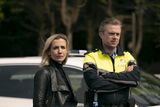The Irish for Sex review: ‘Anything from the waist down wasn’t talked about’
Comedian Bláithín de Búrca goes in search of the lost Irish language of sex in new RTÉ documentary The Irish for Sex
The Irish for Sex
According to a report in The Washington Post from 2012, the claim, frequently dismissed as a myth, that Alaskan Natives have more than 50 different words for snow turned out to be true after all.
Apparently, the latest research had shown that “the Inuit dialect spoken in Canada’s Nunavik region has at least 53”, depending on what kind of snow it was (wet, powdery, packed, etc).
We don’t get all that much of the cold white stuff in this country, so we get along perfectly fine with just “snow”, or if you’re an Irish speaker, “sneachta”.
But as comedian Bláithín de Búrca reveals in her amusing, if sometimes scattershot, bilingual documentary The Irish for Sex (RTÉ1, Thursday, March 14), when it comes to talking about the most fun two people can have without actually laughing, the Irish language has never really been fit for purpose.
Read more
“What is the Irish for clitoris?” is among the many questions she asks (to save you the trouble, it’s “brillín”).
It’s worth pointing out that there was a time when printing that word, in either language, in an Irish newspaper would have resulted in the wrath of the Catholic Church raining down upon the editor’s head like a hail of sharpened rosary beads.
We can print it now, of course, along with other once-forbidden words like “vagina” and “vulva”, without fear of a bishop’s head exploding. But the native tongue, as it was taught to generations of quivering schoolkids by Christian Brothers wielding leather straps or bamboo canes, was full of gaps where the words for various female body parts, and for various sexual practices, should have been.
This is what happens when a religious patriarchy has control of the language, deciding what goes in and what stays out, erasing, excluding, sanitising, suppressing and, by extension, oppressing the female experience and female sexuality.
‘This is what happens when a religious patriarchy has control of language’
“Words may have been lost,” says Dr Sharon Arbuthnot, “or there may never have been any.”
De Búrca’s mother, who taught her Irish and worked for three years on the English-Irish dictionary, recalls how, growing up in the Gaeltacht, women had an Irish word for “testicles”, but none for “vagina”. The only “period” that was ever discussed was the full-stop kind.
“Anything from the waist down wasn’t talked about,” says gaeilgeoir Maire Ní Chinnéide, because all things bodily were considered sinful.
Ireland wasn’t always like this, though. As de Búrca travelled around the country, talking to gaeilgeoirs, historians, artists and fellow comedians, including comedy group The Four Geeze, she delves into rich, earthy linguistic, cultural and sexual history.
This was the Ireland of the Sheela na gigs, the wonderfully bawdy 12th century carvings of women displaying their outsized vulvas, and of the one-of-a-kind Mediaeval manuscript about women’s medicine that refers to “blah banda” — “women’s bloom”, more commonly called menstruation.
Once you got away from Dublin, says artist Siobhán O’Callaghan, a playful Irish-language vocabulary about sex exists, often employing geographical shapes. No prizes for guessing which female body part “góilín/inlet” refers to.
To the delight of de Búrca, who’s a member of the LGBTQ community, she’s shown a stanza from the 12th or 13th century, relating how Finn McCool’s daughter “cast off womanhood to pursue manhood”.
In the Kerry Gaeltacht, de Búrca meets with the members of Allagar na hAoine, a group dedicated to keeping endangered words alive. Their colourful leader Toose Mac Gearailt is an absolute hoot, as well as a font of knowledge.
Toose blames the neutering of the Irish language on matters of sex on city life under the thumb of the Catholic Church. “Ireland was never like that, ever!” he says.
He then proceeds to educate us in how Irish words for breasts (“oft, round ones, or sharp ones standing out”) go back to the 11th century, and that the Irish for “G-spot” is “ball seis”. This knowledge, he says, came from working with farm animals from the age of seven.
Like most documentaries presented by comedians, this sometimes leans a little too heavily into distracting irreverence, but it’s a fresh, engaging, and informative hour of television.
Join the Irish Independent WhatsApp channel
Stay up to date with all the latest news









